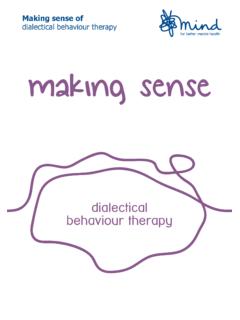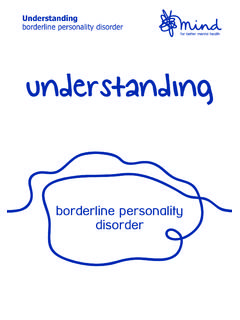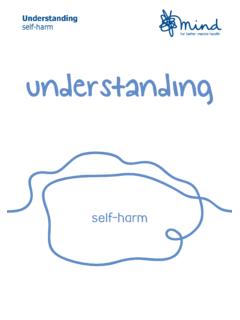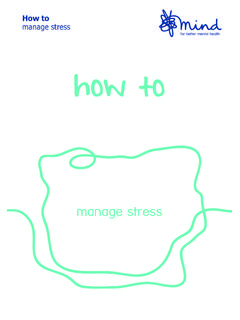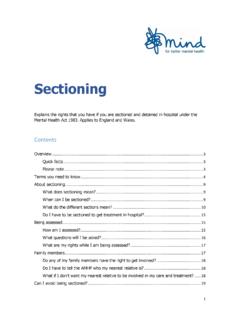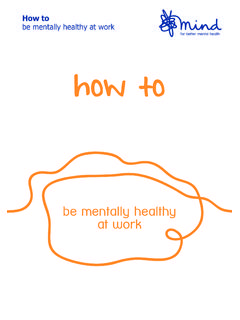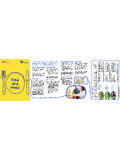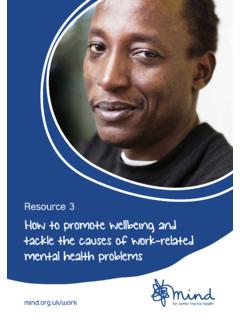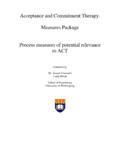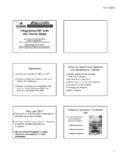Transcription of Making sense of dialectical behaviour therapy …
1 Making sense ofdialectical behaviour therapymaking sensedialectical behaviour therapy Making sense of dialectical behaviour therapyThis booklet explains what dialectical behaviour therapy is, who it can help, what happens during therapy and how to access ContentsWhat is DBT? 4 What is the treatment like? 6 Who can benefit from DBT? 9 How can I access DBT? 12 Useful contacts 144 Making sense of dialectical behaviour therapyWhat is DBT? dialectical behaviour therapy (DBT) is a type of talking treatment. It s based on cognitive behavioural therapy (CBT), but has been adapted to help people who experience emotions very s mainly used to treat problems associated with borderline personality disorder (BPD), but it has also been used more recently to treat a number of other different types of mental health problems (see Is DBT right for me?)
2 What s the difference between DBT and CBT? CBT focuses on helping you to change unhelpful ways of thinking and behaving. DBT also helps you to change unhelpful behaviours , but it differs from CBT in that it also focuses on accepting who you are at the same time. DBT places particular importance on the relationship between you and your therapist, and this relationship is used to actively motivate you to had bounced in and out of mental health services for a long time and nothing had helped, my condition had just Then I started DBT. Now I know what helps me, I have strategies when life is tough.
3 Not everything is plain sailing, but when things go a bit wrong, I bounce back rather than are the goals of DBT?The goal of DBT is to help you learn to manage your difficult emotions by letting yourself experience, recognise and accept them. Then as you learn to accept and regulate your emotions, you also become more able to change your harmful behaviour . To help you achieve this, DBT therapists use a balance of acceptance and change is DBT?What does dialectics mean?In a nutshell, dialectics means trying to balance opposite positions and look at how they go together.
4 For example, in DBT, you will work with your therapist to find a good balance between: Acceptance accepting yourself as you are. Change Making positive changes in your might eventually come to feel that these goals are not as conflicting as they first seem. For example, coming to understand and accept yourself, your experiences and your emotions, can then help you learn to deal with your feelings in a different techniquesAcceptance techniques focus on understanding yourself as a person, and Making sense of why you might do things such as self-harm or misuse drugs.
5 A DBT therapist might suggest that this behaviour may have been the only way you have learned to deal with the intense emotions you feel so even though it s damaging to you in the long-term, and may be alarming to other people, your behaviour actually makes someone is saying yes, it makes sense rather than no, that s wrong .Change techniquesDBT therapists use change techniques to encourage you to change your behaviour and learn more effective ways of dealing with your distress. They encourage you to replace behaviours that are harmful to you with behaviours that can help you move forward with your life.
6 For example, you can learn to start challenging your unhelpful thoughts and develop a more balanced way of looking at sense of dialectical behaviour therapyTo get the most out of DBT requires a certain leap of faith and willingness to have your thinking and behaviours challenged. It is totally different to any other type of therapy I have ever had. It s hard work, but over time and with effort, life starts to get better.(You can find out more about the development of DBT on the official DBT website, BehavioralTech.)What is the treatment like?
7 The way that DBT is delivered can vary between different providers and across different areas. However, there are typically three different types of DBT sessions that you might have and these are likely to be run alongside each other: individual therapy skills training in groups telephone crisis coaching with a therapistDBT pre-treatmentSome therapists may offer you an assessment or pre-treatment phase of DBT. This is where the therapist will look at how suitable DBT is for you. You will typically be offered several sessions where you will learn about the DBT model and, if you decide it is the right therapy for you, you will be asked to make a commitment to the treatment.
8 (See our page on who DBT can help for more information.)Individual therapyIndividual therapy typically involves weekly one-to-one sessions with a DBT therapist. Each session lasts approximately 45 60 individuals sessions have a hierarchy of goals, including: To help keep you safe by reducing suicidal and self-harming is the treatment like? To reduce behaviours that interfere with therapy by addressing any issues that might come in the way of you getting treatment. To help you reach your goals and improve your quality of life by addressing anything that interferes with this, such as other mental health problems like depression or hearing voices, or problems in your personal life such as employment or relationship problems.
9 To help you learn new skills to replace unhelpful behaviours and help you achieve your DBT therapist is likely to ask you to fill out diary cards as homework which you can use to monitor your emotions and actions. You will be asked to bring these cards with you to your therapist each week to help you look for behaviour patterns and triggers that occur in your life. You then use this information to decide together what you will work on in each session. You can find some sample diary cards on the DBT self-help ve learned that emotions are not the enemy.
10 They are useful and have functions. I still feel emotions intensely, but I can now identify them and know how to manage them without using harmful training in groupsIn these sessions DBT therapists will teach you skills in a group setting. This is not group therapy , but more like a series of teaching sessions. There are usually two therapists in a group and the sessions typically occur every week. The room is sometimes arranged like a classroom where your skills trainers will be sat at the front. The aim of these sessions is to teach you skills that you apply to your day-to-day are typically four skills modules:1.


